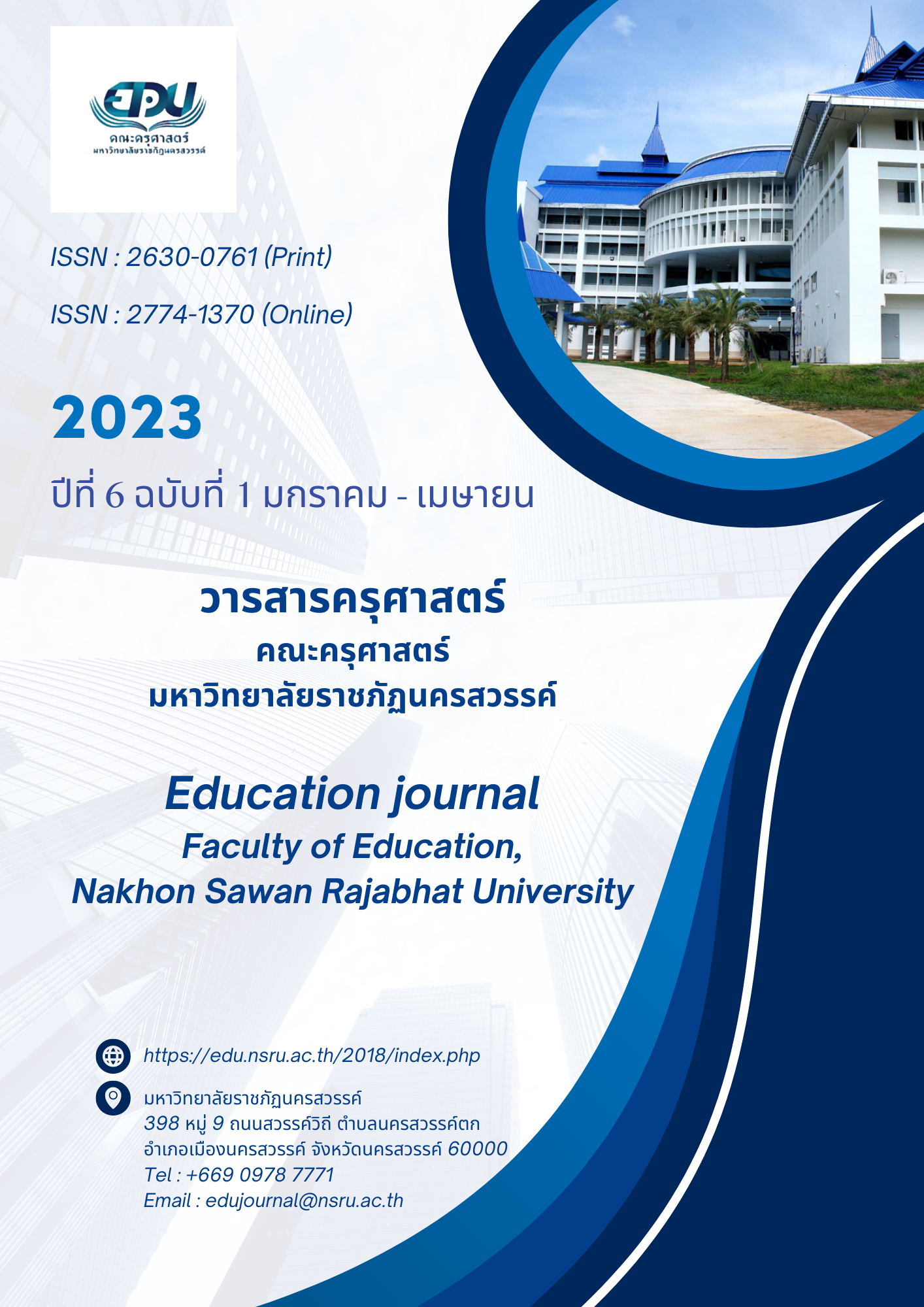Achievement of Critical Reading for Mathayomsuksa 5 Students of Prasarnmit Demonstration School (Secondary) Using Concept-Oriented Reading Instruction and SQP2RS Strategy
Main Article Content
Abstract
The purposes of this research were 1) to compare Mathayomsuksa 5 students’ Prasarnmit Demonstration School (Secondary) critical reading achievement of online texts before and after using Concept-Oriented Reading Instruction and SQP2RS Strategy and 2) study students’ opinions towards learning management using Concept-Oriented Reading Instruction and SQP2RS Strategy. The sample used in this research were 35 students. The research instruments were 1) lesson plans with an Index of Item-Objective Congruence of 1.00. 2) a critical reading achievement test with an Index of Item-Objective Congruence of 0.67 – 1.00, and 3) a questionnaire on the students’ opinions on learning management using Concept-Oriented Reading Instruction and SQP2RS Strategy with an Index of Item-Objective Congruence of 1.00. The data were analyzed in terms of mean, standard deviation, and t-test for dependent samples. The results of this research were as follows:
The achievement of students after using Concept-Oriented Reading Instruction and SQP2RS Strategy was significantly higher than before using Concept-Oriented Reading Instruction and SQP2RS Strategy at the .05 level. The opinions of students on learning management using Concept-Oriented Reading Instruction and SQP2RS Strategy were on “the most” level.
Downloads
Article Details

This work is licensed under a Creative Commons Attribution-NonCommercial-NoDerivatives 4.0 International License.
References
กระทรวงศึกษาธิการ. (2551). ตัวชี้วัดและสาระการเรียนรู้แกนกลาง กลุ่มสาระการเรียนรู้ภาษาไทยตามหลักสูตรแกนกลางการศึกษาขั้นพื้นฐาน พุทธศักราช 2551. กรุงเทพฯ: โรงพิมพ์ชุมนุมสหกรณ์การเกษตรแห่งประเทศไทย.
ชนัญพร ณรงค์ทิพย์. (2556). ผลของการจัดกิจกรรมภาษาไทยโดยใช้กลวิธีเอสคิวพีทูอาร์เอสที่มีต่อความสามารถใน การอ่านเพื่อความเข้าใจและการตอบสนองต่อวรรณกรรมของนักเรียนระดับชั้นมัธยมศึกษาปีที่ 2. วิทยานิพนธ์ปริญญาครุศาสตรมหาบัณฑิต (การสอนภาษาไทย). จุฬาลงกรณ์มหาวิทยาลัย.
ธนวิทย์ กวินธนเจริญ. (2563). การพัฒนาความสามารถในการอ่านอย่างมีวิจารณญาณและการทำงานเป็นทีมของนักเรียนชั้นมัธยมศึกษาปีที่ 4 โดยการจัดกิจกรรมการเรียนรู้ตามกลวิธี SQP2RS. ปริญญาศึกษาศาสตรมหาบัณฑิต (การสอนภาษาไทย). มหาวิทยาลัยศิลปากร.
พรรณี ชูทัยเจนจิต. (2545). จิตวิทยาการเรียนการสอน. (พิมพ์ครั้งที่ 5). กรุงเทพฯ: เสริมสิน พริมเพรสซิสเต็ม.
มณีรัตน์ สุกโชติรัตน์. (2548). อ่านเป็น: เรียนเก่ง - สอนเก่ง. กรุงเทพฯ: นามมีบุ๊คพลับลิชเคชันส์.
มาเรียม นิลพันธุ์. (2558). วิธีวิจัยทางพฤติกรรมศาสตร์และสังคมศาสตร์. นครปฐม: โรงพิมพ์มหาวิทยาลัยศิลปากร.
สกุลรัตน์ เจริญอินทร์พรหม. (2561). การพัฒนาความสามารถการอ่านเชิงวิเคราะห์ของนักเรียนชั้นมัธยมศึกษาปีที่ 2 โดยใช้กลวิธี SQP2RS ร่วมกับแผนผังความคิด. วิทยานิพนธ์ปริญญาศึกษาศาสตรมหาบัณฑิต (การสอนภาษาไทย). มหาวิทยาลัยศิลปากร.
สิริพงษ์ กาละพงษ์. (2563). ผลการจัดกิจกรรมการสอนอ่านแบบ SQP2RS เพื่อพัฒนาความสามารถในการอ่านอย่างมีวิจารณญาณของนักเรียนชั้นมัธยมศึกษาปีที่ 4. วารสารวิชาการศึกษาศาสตร์ มหาวิทยาลัยศรีนครินทรวิโรฒ, 21(1): 60-76.
สำนักงานพัฒนาธุรกรรมทางอิเล็กทรอนิกส์. (2562). รายงานผลการสำรวจพฤติกรรมผู้ใช้อินเทอร์เน็ตในประเทศไทย ปี 2561 Thailand Internet User Profile 2018. กรุงเทพฯ: กระทรวงดิจิทัลเพื่อเศรษฐกิจและสังคม.
สุธีรัตน์ อักษรกาญจน์. (2553). ผลของการเรียนการสอนอ่านแบบเน้นมโนทัศน์ที่มีผลต่อความสามารถในการอ่านภาษาไทยเพื่อความเข้าใจและแรงจูงใจในการอ่านของนักเรียนมัธยมศึกษาปีที่ 2. วิทยานิพนธ์ปริญญาครุศาสตร มหาบัณฑิต (การสอนภาษาไทย). จุฬาลงกรณ์มหาวิทยาลัย.
อโนมา โรจนาพงษ์, พันตำรวจตรีหญิง. (2554). การเพิ่มผลลัพธ์การอ่านภาษาอังกฤษของนักเรียนนายร้อยตำรวจโดย การเรียนการสอนแบบเน้นมโนทัศน์ในบทความวิจัย: การทดลองภาคสนาม. ปริญญาครุศาสตรดุษฎีบัณฑิต (วิธีวิทยาการวิจัยการศึกษา). จุฬาลงกรณ์มหาวิทยาลัย.
Anderson, E., & Guthrie, J. T. (1996). Teaching with CORI: Talking the big jump. The National Reading Research Center.
Cooper, J. D., & others. (1988). To What and How to Reading Instruction. Ohio: Merill Plublishing.
Echevarria, J., &Vogt, M. (2008). 99 Ideas and activities for teaching English learners with the SIOP model. Boston: Allyn and Bacon.
_______. (2010). Making content comprehensible for secondary English learner: The SIOP model. Boston: Allyn and Bacon.


